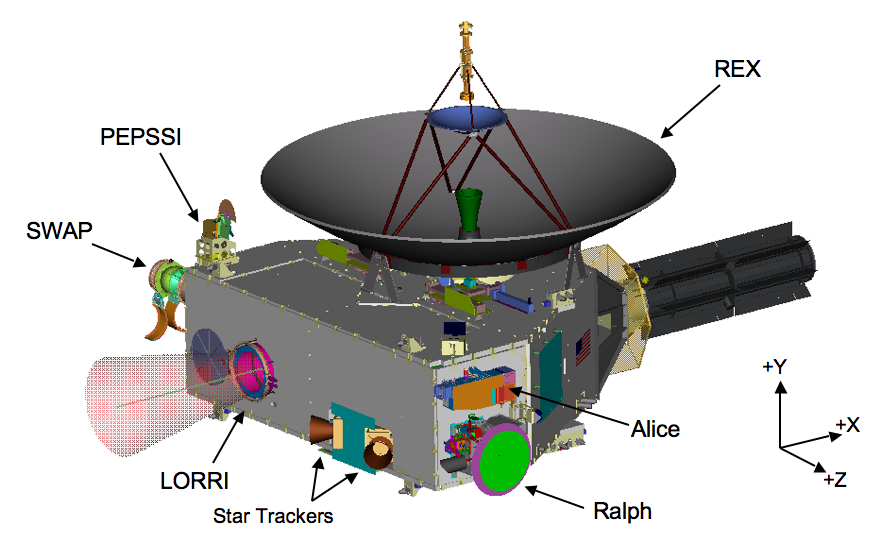
LORRI is comprised of a Ritchey-Chrétien telescope and a 1024 x 1024 pixel (optically active region) CCD detector operated in frame-transfer mode. The telescope has a 20.8 cm diameter primary mirror, a focal length of 263 cm, and a three lens field-flattening assembly (see Fig. 1).
LORRI does not have any color filters; it provides panchromatic (black and white) imaging over a wide spectral region extending approximately from 350 nm to 850 nm. This was done to make LORRI as sensitive as possible for imaging objects in the Pluto system, where light levels are 1000 times lower than at Earth, and also to keep LORRI as simple as possible.
LORRI has a 0.29° x 0.29° field of view, and each pixel subtends 0.00028° x 0.00028° (1.02 arcseconds x 1.02 arcseconds). LORRI can also operate in a so-called "rebin" mode (also called "4x4 mode") in which on-chip binning (pixel co-addition) is used to change the output format to a lower resolution, 256 x 256 pixels. This mode is sometimes used when long exposure times are required (i.e., when the 1x1 mode images would be badly smeared by pointing drift) or for observations attempting to achieve high sensitivity to diffuse emission.
The LORRI program is managed by the Johns Hopkins University Applied Physics Laboratory (JHU/APL) in Laurel, Maryland. The telescope was built by SSG Precision Optronics, Inc. of Wilmington, Massachusetts, and the CCD was supplied by e2v of Chelmsford, England. The LORRI Principal Investigator is Dr. Andy Cheng of JHU/APL.
LORRI images typically contain a handful of cosmic ray strikes, which are not removed by the calibration processing. These often appear as single, bright pixels, but sometimes they produce streaks of several bright pixels. They are usually fairly easily distinguished from the images of real astronomical objects (e.g., stars, planets, or satellites).
LORRI images are recorded on the spacecraft as 12-bit integers with light level values from 0 to 4095. The groundbased calibration processing converts the images to 32-bit double-precision numbers. For display on this web page, the calibrated images are then converted to 8-bit JPEG files (i.e., images with 256 intensity levels) using a linear scaling stretch that maps the minimum intensity in the calibrated image to 0 and the maximum intensity to 255. Thus, the web images do not record the actual CCD signal level; nor do they retain the full dynamic range of the original images. As a result, some images that appear blank on this page actually have important data in them, but this cannot be seen in the automatically-converted 8-bit JPEGs posted here.
The following ancillary information is provided for each image posted: the date of the observation in coordinated universal time (UTC) at the New Horizons spacecraft, the exposure time of the image in milliseconds, the name of the target, and the range to the target in kilometers (i.e., the distance between the New Horizons spacecraft and the target; for example, 12.1M km means 12.1 million kilometers).
If you plan to use or post any of these images, see the New Horizons Image Use Policy.
A1. An image can look black if a star or cosmic ray event is so bright that it skews the intensity scale of the JPEG image. In this case, there is a big intensity gap between the brightest object and everything else in the scene, and the important scene information is relegated to a small range of intensities near the bottom of the available brightness range.
Q2. Why is the target sometimes near the edge of the field of view?
A2. For most of the LORRI images, the target is placed near the center of the field of view (FOV). But for some images, the target is intentionally placed near the edge of the FOV, for example, to test a property of the instrument (e.g., the scattered light properties of the telescope), or to prevent saturation (e.g., some regions of Jupiter saturate the CCD when Jupiter completely fills the FOV, owing to the CCD readout smear issue discussed above).
Q3. Some of images show diffuse arc-like features. Are those real?
A3. When very faint objects are observed near very bright objects, particularly when the bright object is just outside the nominal field of view, LORRI images have "ghosts" that are produced by multiple reflections within its optics. These ghosts look like arcs, or partial arcs, with the exact appearance depending on the location and size of the bright object.

Fig. 1: These are cutaway drawings of LORRI showing the telescope baffle tube, the telescope structure, the primary (M1) and secondary (M2) mirrors, the field-flattening assembly, the focal plane assembly (FPA), which consists of the CCD and its electronics, and the radiator that keeps the CCD cold to minimize electronic background noise. The primary mirror diameter is 20.8 cm (8.19 in).

Fig. 2: This drawing shows the location of LORRI and the other instruments on the New Horizons spacecraft. LORRI looks approximately along the X direction with a field of view indicated by the pink cone. The star trackers, which are used to determine the spacecraft attitude, view directions that are offset by approximately 45° relative to LORRI. The antenna diameter is 2.1 m (6.9 ft), which provides a scale for the figure.